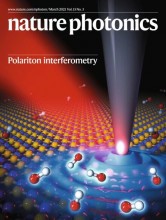Related news by tag Nano-FTIR
Nanoparticles as drug carriers

Due to their size, the physical properties of nanoparticles are very different from those of macroscopic materials, even when they have the same chemical composition. Therefore, the use of nanoparticles to administer drugs has revolutionised the fields of both nanotechnology and medicine.
'When administering a drug, in order to guarantee efficient performance, it is vital to ensure it is effectively delivered to the right place. Nanoparticles are able to store and transport drugs to the required site in an effective manner. It is best to load them with the maximum possible quantity of the drug in question, providing the particle remains stable,' explains Iban Amenabar, a researcher with nanoGUNE's Nanoóptica team. 'To do so, we obviously need techniques to enable us to measure the real quantity of the drug present in the nanoparticles. However, establishing said techniques is no easy matter,' he continues. 'Conventional measurement techniques (such as FTIR–Fourier transform infrared spectroscopy) offer limited spatial resolution and sensitivity, and only enable drug load measurements in samples containing thousands of nanoparticles. Unfortunately, this amount is not representative, since the drug may not be stored or loaded in the nanoparticles, which means it will not be transported and delivered effectively.' Thus, 'in order to determine the real, effective load, it is necessary to measure the amount of the drug in individual nanoparticles. To do this, we use the nanoscale Fourier transform infrared spectroscopy (nano-FTIR) technique, which was developed at nanoGUNE. This novel technique enables us to measure both optical images and absorption spectra with nanometric resolution and sensitivity. Specifically, the collaboration has enabled us to measure and identify drugs in individual nanoparticles for the very first time,' he adds.
The nano-FTIR technique combines the analytical capability (or chemical information) of Fournier transform infrared spectroscopy (FTIR) with the nanoscale spatial resolution of atomic force microscopy (AFM).
'As a result of the collaboration project, we were able to demonstrate the potential of the novel spectroscopy technique for analysing nanoparticles. Thanks to this technique, we can now measure and identify the drugs present in individual nanoparticles, based on the formulations developed by Kusudama Therapeutics S.L for treating various different types of lung disease,' explains Iban Amenabar.
It is important to highlight the fact that this collaboration has opened up new avenues of research aimed at ensuring greater control over nanoparticles with a wider variety of drugs.
In this particular case, the aid provided by Fomento de San Sebastián was channelled through the Technological Bonds programme, set up in collaboration with CIC nanoGUNE and other entities to promote and develop projects with a strong technological component among local companies and entrepreneurs. The programme seeks to foster the transfer of the technology and knowledge generated in research centres based in San Sebastián.
CIC nanoGUNE´s research on light covered in Nature Photonics
Light plays an essential role in modern science and technology, with applications ranging from fast optical communication to medical diagnosis and laser surgery. In many of these applications, the interaction of light with matter is of fundamental importance.


